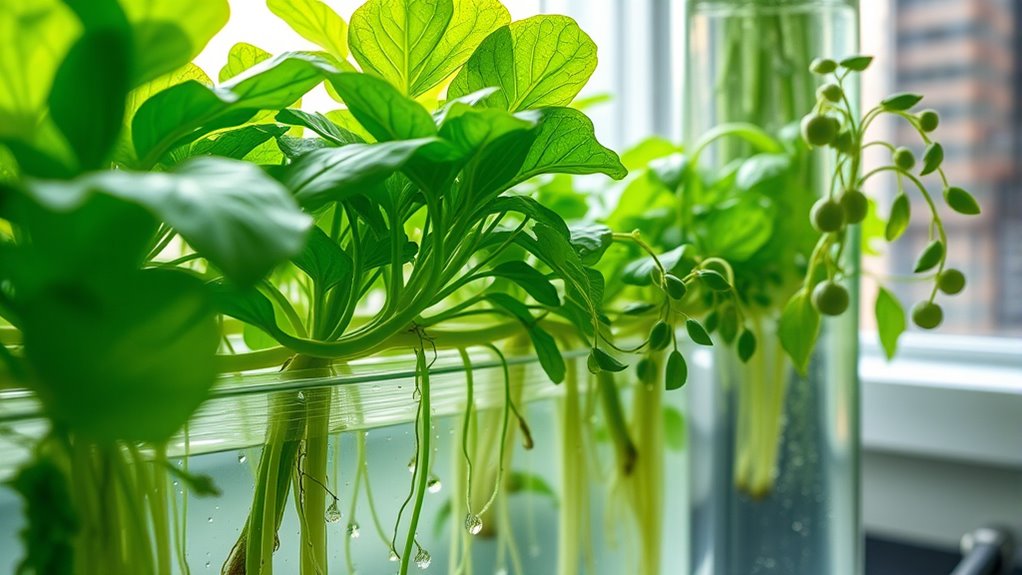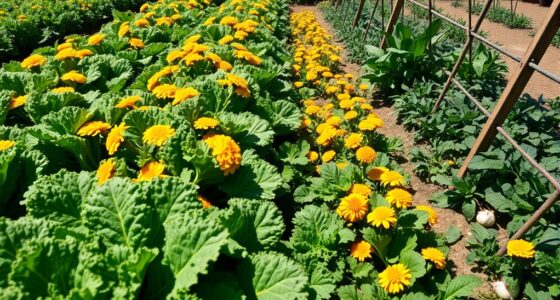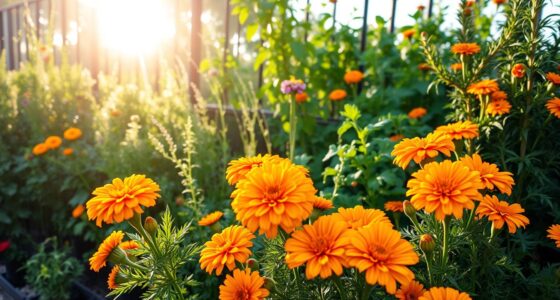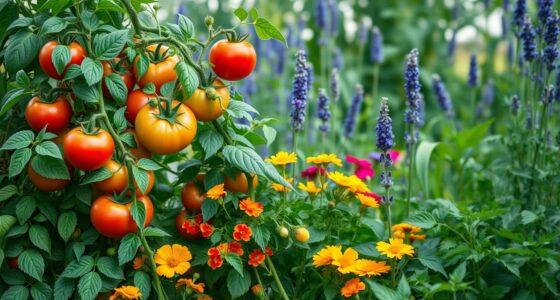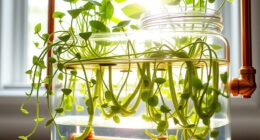Yes, plants can share water successfully in hydroponic systems if you maintain proper circulation and nutrient balance. Consistent water movement ensures all plants receive the necessary nutrients and oxygen, preventing stagnation and root problems. Regularly monitoring pH, temperature, and water quality helps keep conditions ideal for sharing. With the right equipment and management, your plants will thrive together. Keep exploring to discover how to enhance your hydroponic setup for even better results.
Key Takeaways
- Plants in shared hydroponic systems can access nutrients simultaneously if water circulation is properly managed.
- Maintaining correct pH and temperature ensures efficient water sharing and healthy plant growth.
- Proper system design, like NFT or drip setups, promotes even water distribution among plants.
- Reliable pumps and filtration prevent stagnation and contamination, supporting successful water sharing.
- Consistent monitoring and adjustments help prevent deficiencies and ensure all plants receive adequate nutrients.
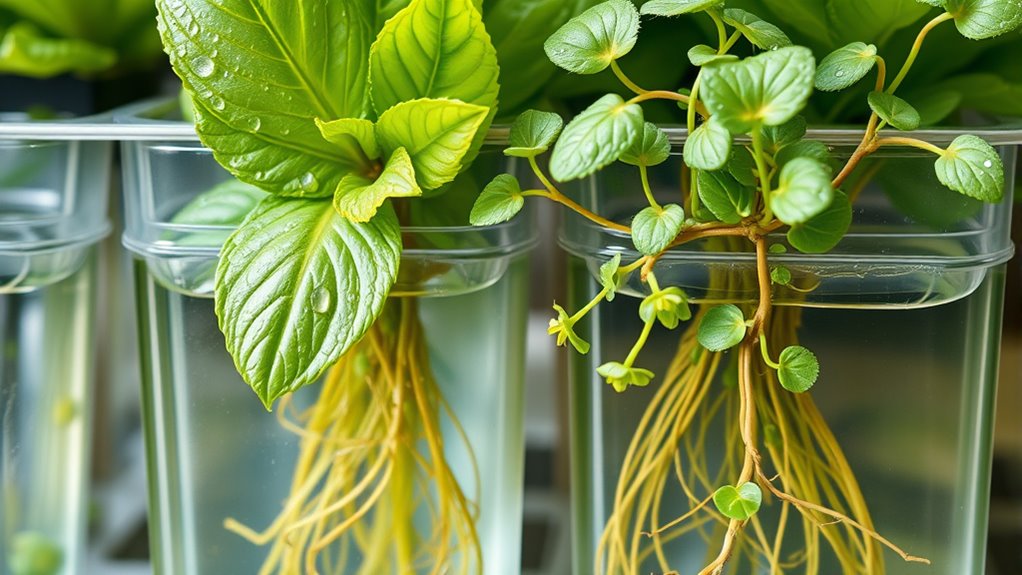
Hydroponic Pals makes growing plants easier and more exciting by letting you cultivate your favorite greens without soil. Instead of traditional gardening, you’re working with a soil-less system that relies on precise control of water and nutrients. When you set up your hydroponic system, one of the key factors to consider is how plants share water successfully. The answer lies in understanding how plant nutrients and water circulation work together to keep your plants healthy and thriving.
In hydroponics, each plant needs access to a balanced plant nutrient solution, which supplies essential minerals and elements that soil would normally provide. Since the plants are sharing water, the nutrient solution must be carefully managed. If the nutrient mix is off, some plants may not get enough nutrition, leading to stunted growth or deficiencies. Water circulation becomes critical because it ensures that the nutrient-rich water moves consistently around the roots of each plant. Proper water circulation prevents stagnation, reduces the risk of disease, and guarantees that each plant receives a steady supply of fresh nutrients.
You need to think about how your system circulates water—whether you’re using a drip system, NFT (nutrient film technique), or deep water culture. Whatever method you choose, the goal is to keep the water moving smoothly, avoiding dead zones where stagnant water can cause problems. When water circulates effectively, it keeps oxygen levels high around the roots, which is vital for healthy plant growth. Without proper circulation, roots can drown in waterlogged conditions or become weak from lack of oxygen, impairing their ability to absorb nutrients.
Sharing water successfully in a hydroponic system also means maintaining the right pH level and temperature. If the water becomes too acidic or alkaline, nutrient uptake gets disrupted. Similarly, if water temperature is too high or low, it can hamper circulation and root health. Regularly checking and adjusting these parameters ensures that all plants share water efficiently and stay healthy.
Additionally, employing high-quality water pumps and filtration systems can enhance circulation and help prevent issues like clogging or contamination. Ultimately, the success of sharing water in hydroponics hinges on your ability to maintain consistent water circulation and supply the right plant nutrients. When these elements are balanced, your plants will grow faster, stronger, and more flavorful. Hydroponic Pals makes it easier to monitor these factors, giving you the confidence to grow a thriving, soil-free garden. You’re in control of your system, and with proper water sharing, your plants will flourish together in harmony.
Frequently Asked Questions
Can Different Plant Species Coexist in the Same Hydroponic System?
You might wonder if different plant species can coexist in the same hydroponic system. It’s all about plant compatibility and species diversity. When choosing plants, guarantee they have similar nutrient needs and growth habits to avoid competition and ensure healthy growth. Mixing compatible species can increase biodiversity and make your system more resilient. Just be mindful of their light, water, and space requirements, so everyone thrives together.
How Do Plants Communicate or Signal Water Needs to Each Other?
Think of plants as tiny phone lines, constantly sending signals through their roots. When they need water, they use plant signaling to send chemical messages, telling neighboring plants or their roots to adjust water uptake. This water communication helps maintain balance in a shared environment. You can observe this process in action, as plants react quickly to changes, showing how they actively share and respond to water needs without direct contact.
What Are the Risks of Cross-Contamination Among Plants Sharing Water?
You should be aware that sharing water among plants poses risks of pathogen transfer, which can lead to disease spread. When plants are connected through shared water systems, harmful microbes can easily move from one plant to another. This increases the chance of infections and compromises plant health. To minimize these risks, maintain clean water systems, monitor plants regularly, and avoid sharing water if signs of disease appear.
Do Plants Share Nutrients Along With Water in Hydroponic Setups?
In hydroponic setups, plants do share nutrients along with water through nutrient-rich solutions. As your plants grow, their roots interact with this shared water, allowing nutrient transfer between roots and the solution. These root interactions help plants absorb essential nutrients efficiently. However, it’s important to monitor nutrient levels regularly, as imbalances or cross-contamination can affect plant health and growth.
How Does Plant Size Affect Water Sharing in Hydroponic Systems?
You might think plant size doesn’t matter for water sharing, but it actually influences water uptake considerably. Larger plants have more extensive root systems, allowing them to absorb more water, which can limit smaller plants’ access. In hydroponic systems, understanding how plant size affects water sharing helps you manage flow rates and spacing. This ensures all plants get enough water, preventing competition and promoting healthy growth.
Conclusion
So, as you explore hydroponic systems, remember that plants sharing water isn’t just a theory—it’s a surprisingly natural coincidence. When you see how certain species thrive side by side, it’s almost as if they’re meant to share this life-giving resource. With careful monitoring, you might find that your plants not only survive but flourish together, proving that sometimes, nature’s best solutions happen when you least expect it.
